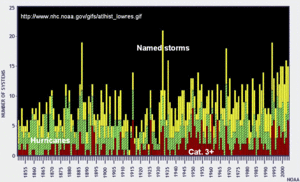Using Hurricane Web Resources in Your Classroom
- How should New Orleans be rebuilt?
- Are strengthening hurricanes associated with global climate change? What are the present and future risks associated with hurricanes off the Gulf Coast?
- What are the lessons learned from Hurricane Katrina?
Role Playing Exercises:
How should New Orleans be rebuilt?
Jigsaw Method:
Using this method, students are assigned to investigate different aspects of the same problem or issue. For example, each team might analyze a different but related data set or read an article on different aspects or viewpoints on the same topic. Once each team member thoroughly understands his/her team's aspect of the problem, new groups are formed with at least one representative from each original team. Each individual then explains her/his team's aspect of the problem to the new group. In this way, each student learns every aspect of the problem. Groups then use combined information to evaluate a summary issue [Tewksbury, 1995] .
Are increasingly stronger hurricane seasons associated with global climate change?
Investigative case-based learning
Using this method, students are asked to investigate the response and long-term affects of Hurricane Katrina one year later. Students will structure their own learning through the context of retrospective reports regarding Hurricane Katrina. The case defines the general area of geoscience under investigation and students generate questions based both on their interests and prior knowledge that relates to the topic of study. Students will analyze the case, investigate questions and produce support for their conclusions.
Read more about investigative case based learning
What are the lessons learned from Hurricane Katrina?
Earth System Approach

Earth System Science acknowledges that changes in the land result from interactions among many 'spheres' such as the atmosphere, hydrosphere, biosphere, lithosphere and anthrosphere (human dimensions). Entry level courses based on an earth system approach integrate solid earth, atmospheric and ocean science in a coherent way, emphasizing their interactions and complementary roles in the earth system. Moreover, simple dynamic modeling programs have made it possible for undergraduate students to improve their quantitative understanding of how the earth system works. At the graduate school and professional level, Earth System Science has led to a wealth of exciting interdisciplinary research that increases our understanding of the earth and planets. The intricacy of the relationships between climate, physical geography, human developments, and the impacts on human life as related to Hurricane Katrina are best understood through an earth systems approach. Any unit that discusses the science and policy issues related to Hurricane Katrina would benefit from an earth system approach.
In your classroom, you can use an earth system approach to discuss howearth science can inform policy or what earth science can add to the political and sociological debates regarding the aftermath and disaster caused by Hurricane Katrina.
Starting Point
The Starting Point project is exploring the ability of online resources to catalyze improvements in undergraduate teaching. The goal is to develop a resource that intimately integrates pedagogy with teaching resources and fully supports a virtual community of educators. The resources on this site attempt to bridge the gap between information about teaching methods and the everyday experiences of geoscience faculty by providing geoscience specific arguments and examples. Starting Point tries to provide all of the information needed for a faculty member or graduate student to make an informed decision about the methodology that they use in a particular teaching situation, and to implement a technique easily and well. Starting Point is a great place to go if you are hoping to use the Hurricane Katrina information with entry-level geoscience students.



